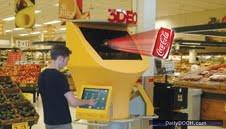Provision Interactive Technology’s 3D
Gail Chiasson, North American Editor
When we received a press release recently that discussed the rousing success of a typical pizza chain franchise store that realized a staggering 170% increase in sales based mainly on a 3d advertising campaign, we figured it’s time we talked to Curt Thornton, CEO of Provision Interactive Technology Inc. in Chatsworh, California, provider of that eight-week 3D campaign.
 Thornton is a great proponent of the 3D world. In fact, he expects that 3D is going to play a significant roll in the rapid growth of digital out-of-home.
Thornton is a great proponent of the 3D world. In fact, he expects that 3D is going to play a significant roll in the rapid growth of digital out-of-home.
“This is no longer a novelty,” says Thornton, whose company is providing 3D advertising without glasses in 50 regional grocery stories (25 now operational) in the Los Angeles area and will soon have 3D advertising in one of America’s largest pharmaceutical chains. It also has 3D displays in convenience stores but not in reward center format. “I know that 3D advertising outperforms traditional 2D in-store media, but the results of the company’s that latest case study even surprised me.”
That program, whereby a national pizza chain ran a short 3D ad on Provision’s Rewards Centers, gave customers the option to print a coupon for the chain from the kiosks. The result was tens of thousands of coupons printed, with many being redeemed the same day. One store owner said, “We sold out of Pepsi and pizza and had to turn people away.”
Thornton says, “If we execute as planned, by the end of 2011, we’ll have upwards of 1,000 retail locations across the country. And we’ll soon be announcing significant advertisers.”
Provision Rewards Centers are positioned in a high-traffic, high-visibility locations close to the main traffic entrance of each store, where customers are already in a mindset to purchase items.Using Provision’s Holo patented 3DEO floating image display inside the 3DEO Rewards Center, this new ‘disruptive’ technology is used to advertise all types of products and services within the store, breaking through the clutter of traditional in-store ads. When consumers interact with the touch screen, they are rewarded with the selection of a promotion or coupon of their own choice to use in the store. The 3D displays feature digital streaming images that float in space without the need for special glasses – and Provision is now also moving into gesture recognition.
“We distinguish ourselves by being first-to-market and the largest, and I really feel that our product is superior to what competitors are offering,” says Thornton. “We’re superior to flat screens and we’re exploring new opportunities, for example, in casinos and in-house gaming. Our product can virtually replace any TV, LCD or Plasma screen.
“For retailers, it’s a fun and entertaining product which can include a loyalty program if they so want. They get cutting-edge technology, a sales lift, continuous branding, and a revenue share incentive.
“The advertisers get branding, and our studies show a 10%-to-40% sales lift. It’s great for new product launches.”
While Provision’s Reward Centre kiosks are being integrated into grocery stores and, soon, in smaller format, into pharmacies, Provision’s 3D screens (17”, 29” and 40”) are seen hanging in convenience stores such as 500 Circle K outlets in the western U.S.. Sound is optional, but usually is integrated in the grocery store Rewards Program kiosks.Provision spent its first five years in R&D and patent registrations, and initially supported itself with sales of hardware, eventually transitioning to a recurring advertising revenue model with its 3D technology. Thornton, who earlier worked in high technology, mainly in the entertainment and computer sectors, founded Provision and brought in its management team. For advertising sales, it has two people handling its house accounts and major brands, and also uses Charter Digital Media and Adcentricity, both in New York.
“The success of Avatar really changed the way people see 3D and opened the door to the 3D experience,” says Thornton. “I think that we’re going to see phenomenal growth over the next five years.”
While management owns about 46% of the company, a major investor is Catalpa.



Follow DailyDOOH